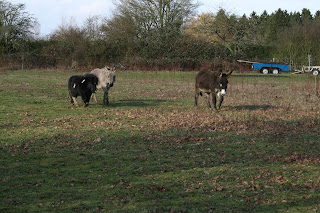The more photographs you take and subsequently look at on the computer, the more it makes sense and becomes a more natural way of thinking.
I have chosen Raw Materials of Food as the subject for my assignment.
Single Point dominating the Composition
Shutter 1/60 ...... f 5 ....... ISO 400
I was very happy with this picture, it was exactly what I was imagining and planning. On my first outing I couldn't find a squash. I did take other versions of this shot. The first with a red pepper, which was not giving the exact single point that I wanted.
The other standby shot I had was the base of an orange, it was clear, well focused and a good colour.
This my final image, I have cropped the picture slightly, I did like the original but the background was a little distracting.
Two Points
Shutter 1/60 ...... f 4.0 .......ISO 400
Two points I found more difficult, especially with food stuffs. This first picture that I had did lead your eye from one point to another, its the girl cooking the curry, first you look at the curry then onto the girl, but I not sure if they fit into the 'raw stuffs' category.
The Picture that I settled on is the following one, although i'm not a lover of cling film. This is my choice of picture for two points, of the melon halves.
Several Points in a Deliberate Shape
Shutter 1/60 ........ f 5.6. .....ISO 400
Thanks go to my local butcher who allowed me to take these pictures of his hams. On driving past I noticed these and thought the would be perfect for this heading. Several similar points all hanging in a curve shape. They looked artificial but the butcher assures me they are real.
Combination of Vertical and Horizontal
Shutter 1/60 ........f 4.0 .......ISO 400
The first picture that I had was of boxes of dates, stacked, giving vertical and horizontal lines. Also similarly at Borough Market there were boxes of Red currants, which looked delicious. The picture I have chosen is one from the cheese stall, this was its shelving, stacked with various goodies. The box housing gives the horizontal and vertical lines.
Diagonals
Shutter 1/100 ........ f 7.1....... ISO 400
This was taken at the market in Cambridge, first of all I included the box in my picture, but decided to go in really close, and this was my preferred picture. They were set in a diagonal pattern in their box, also the diagonal is going across the picture.
Curves
Shutter 1/60 ........ f 4.0 ........ISO 400
I had various pictures of fruit which in itself is curvaceous as were many of the fish, or the arch of the spines. This picture that I have chosen is of the colourful Virgin Olive Oil cans on the curved stand and display. I love the yellow and blue together.
Distinct, even if irregular, shapes.
I thought these cups were good with the heading, the cup shape is regular, along with the orange colour of the juice, all makes them distinct. The random angles of the straws makes them slightly irregular.
Two Implied Triangles
Shutter 1/60 ....... f 4.0 ....... ISO 400
Here's hoping you are not a vegetarian !
Initially I was looking at the pigs head as my triangle, using his two ears and nose. The cheery butcher decided to continue his show and 'jazz hands' for me, he had been entertaining the children, but I still have my triangle, including his two hands and the pigs head.
Shutter 1/60 ....... f 4 .0 ........... ISO 400
This second picture is a reminder of my own back garden, I'm thinking of going into business ... Uppermost is the blackboard forming the apex of the triangle, with the two clusters of animals forming the other two points, giving the implied triangular shape.
Rhythm
Shutter 1/6 ....... f 4.0 .......ISO 400
Lots of the fruits have rhythm, when its laid out on display, with its regular shapes all laid together, and constant colour.
I picked the picture of the figs, because they were the nicest figs I've seen for a long while.. perfectly ripe and their beautiful soft green colour. It is the colour and shape that gives the rhythm, along with the stalks.
Pattern
Shutter 1/60 ...... f 4.0 ........ISO 400
There is pattern here firstly in the different types of mushrooms, which are then laid out in a stripe pattern, with herbs making a surrounding border. Each individual section of mushrooms would make their own pattern also.
As I have realised before when initially reading through the exercises and assignments, you have ideas and ways you want to take your photographs but they don't always come to fruition when you have your camera in hand..
Also some of the ideas you have don't actually work when you look at them, which is quite disappointing.
The Implied Triangles and curves have now finally registered, I'm hoping with more practice they will feel more natural. Once you do get to grips with them its easier to see them in everyday situations, in photos that you take and ones that you see in the press, magazines and books.
ALTERATIONS TO ASSIGNMENT 2
Implied Triangle
Pattern
Rhythm






















































